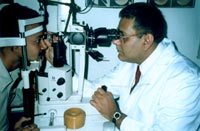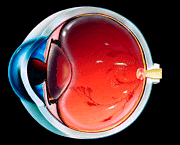 Diabetic
retinopathy is one of the leading causes of blindness
among adults in the world. Approximately 25% of current
diabetics have some form of the disease. The risk of developing
diabetic retinopathy increases with the age of the diabetic
person and the duration of the disease. It is estimated
that 90% of diabetics may experience some form of diabetic
retinopathy over the course of their life. However, only
a small percentage of those developing diabetic retinopathy
have serious vision problems, and even a smaller percentage
become blind. Diabetic
retinopathy is one of the leading causes of blindness
among adults in the world. Approximately 25% of current
diabetics have some form of the disease. The risk of developing
diabetic retinopathy increases with the age of the diabetic
person and the duration of the disease. It is estimated
that 90% of diabetics may experience some form of diabetic
retinopathy over the course of their life. However, only
a small percentage of those developing diabetic retinopathy
have serious vision problems, and even a smaller percentage
become blind.
Diabetic
retinopathy is a complication of diabetes mellitus which causes
abnormalities in the tiny blood vessels nourishing the retina.
These vessels weaken, leak fluid and blood, and fail to provide
nutrients necessary for good health in the retina. Left untreated,
diabetic retinopathy can result in severe visual loss, including
blindness.
Though
vision may gradually become blurred, significant loss of sight
does not usually occur with background retinopathy. Since
the patient does not experience pain or external symptoms
such as bloodshot eyes or discharge, changes in the retina
can go unnoticed unless detected by an eye examination.

A
comprehensive eye examination is the best protection against
the progression of diabetic retinopathy. The Sunetra Eye Centre
can diagnose and treat diabetic retinopathy.
The innermost
layer of the eye is composed of a delicate tissue called the
retina which is comparable to the film within a camera. Visual
impulses are received by specialized cells in the retina and
transmitted to the brain via the Optic Nerve. The area which
is responsible for enabling us to see clearly is called the
Macula. Diabetic Retinopathy is the term applied to specific
changes in the retina which can occur in people with diabetes
mellitus. The incidence of diabetic retinopathy seems to be
directly related to the duration of diabetes rather than to
its severity or control.
The changes involve the small blood - vessels of the retina.
The inner lining of these blood vessels are weakened and small
outsourcings occur. These are termed Micro - aneurysms the
blood vessels also become abnormally permeable and allow substances
to leak freely into spaces where they should not normally
enter. This results in water logging called oedema and deposition
of material on the retina which is called Exudates. These
changes will cause symptoms of blurred vision if situated
at the macula. The more serious changes in diabetic retinopathy
is the closure of the retinal capillaries.
This starves the retina of oxygen and stimulates the growth
of abnormal blood vessels on the retina. These abnormal blood
vessels are brittle and are a potential danger because they
bleed easily. Such bleeding occurs either between the jelly
within the eye (called the vitreous) and the retina or into
the jelly itself. Such bleeds may clear spontaneously or may
remain as such. Sometimes repeated bleeds occur and with passage
of time leads to fibrous tissue formation which can contract
and pull on the retina causing it to detach.
An eye
with marked changes of diabetic retinopathy can have good
vision and be totally symptomless. A reduction in vision occurs
if the macula becomes water - logged, becomes involved in
traction retinal detachment or if a vitreous hemorrhage locates
itself in front of the macula. Seeing black spots, floating
objects of various shapes and sizes and cob - webs are usually
symptoms which point to a bleed inside the eye.
However,
not all people with these symptoms have the changes within
the eye that have been just described and only an examination
of the retina by the eye doctor will help to clarify the situation
. it may be gratifying to note that every diabetic need not
have diabetic retinopathy.
Photocoagulation
helps in preventing severe visual loss in eyes which run such
a risk and vitreous surgery helps in restoring vision in eye
where vision is severely affected by the disease process.
Till today there is no medication either in the form of eye
drops, oral tablets or injections that can prevent or cure
diabetic retinopathy.
Patients
who have diabetes mellitus but no diabetic retinopathy and
those with minimal diabetic retinopathy do not need any treatment.
They must however be carefully followed up periodically. However
there are a group of patients who have very advanced disease
where neither photocoagulation nor vitrectomy can help.
|


 Diabetic
retinopathy is one of the leading causes of blindness
among adults in the world. Approximately 25% of current
diabetics have some form of the disease. The risk of developing
diabetic retinopathy increases with the age of the diabetic
person and the duration of the disease. It is estimated
that 90% of diabetics may experience some form of diabetic
retinopathy over the course of their life. However, only
a small percentage of those developing diabetic retinopathy
have serious vision problems, and even a smaller percentage
become blind.
Diabetic
retinopathy is one of the leading causes of blindness
among adults in the world. Approximately 25% of current
diabetics have some form of the disease. The risk of developing
diabetic retinopathy increases with the age of the diabetic
person and the duration of the disease. It is estimated
that 90% of diabetics may experience some form of diabetic
retinopathy over the course of their life. However, only
a small percentage of those developing diabetic retinopathy
have serious vision problems, and even a smaller percentage
become blind.
